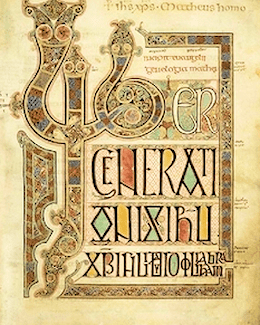Textus Receptus Bibles
Wessex Gospels c.1175
Anglo-Saxon
| 2:1 | Note: Nuptie facte sunt in chana galilëë. On þam þriddan daige wæren gyfte ge ge-wordene (sic) on chana galilëë. ænd þas halendes moder wæs þær. |
| 2:2 | Soðlice se halend ænd hys leorning-cnihtes wæren ge-laðode to þam gyftan. |
| 2:3 | & þa þæt win ge-trukede þa cwæð þas hælendes moder to hym hyo nabbeð win. |
| 2:4 | Þa cwæð se halend to hire. la wif. hwæt ys me & þe; gyt min time ne com. |
| 2:5 | Ða cwæð þas halendes moder to þam þenum; doð swa hwæt swa he eow segge. |
| 2:6 | Ðær wæren soðlice a-set syx stenene water-fate. æfter iudea ge-clensunge. ælc wæs on twere sestra ge-mette. oððe on þreora. |
| 2:7 | Ða bead se halend þæt hyo þa fate mid watere ge-fyldon. & hyo ge-felden þa odð (sic) þanne brerd. |
| 2:8 | Ða cwæð se halend. hladeð nu. & berað þare drihte ealdre & hy naman. |
| 2:9 | Ða se drihte ealder þæs wines on-byrgde. þe of þam wætere ge-worðan wæs; he nyste hwanen hyt com. þa þenas soðlice wisten þe þæt water hloden. Se drihte ealdor clipende (sic) þanne bridgumen |
| 2:10 | & cwæð to hym; ælc man sylð ærest god win. & þonne hyo drunkene beoð. þæt þe wyrse beoð. Ðu þe ge-heolde þæt gode win oð þys. |
| 2:11 | Ðis wæs þæt forme taken þe se halend worhte on chana a-galilëë & ge-sutelode his wuldor & hys leorning-cnihtes ge-lyfdon on hine. |
| 2:12 | Æfter þisen he and hys moder & hys ge-broðra & hys leorning-cnihtes foron to capharnaum & wuneden þær feawan dagen. |
| 2:13 | Ænd hyt wæs neah iudea eastron & se halend for to ierusalem |
| 2:14 | & ge-mette on þam temple þa þe sealdan oxan. & scep ænd culfran. & sittende meneteres. |
| 2:15 | & he worhte swipan of strengen & hyo ealle of þam temple adraf ge sceap. ge oxan. & he ageat þare menetera feoh & to-warp heoræ mysan. |
| 2:16 | & sægde þam þe þa culfran cypton doð þas þyng henon. ne wyrce ge mines fæder hus to mangun-huse. |
| 2:17 | Ða ge-mundon hys leorning-cnihtes þæt ðe awriten is. þines huses ände me ëtt. |
| 2:18 | Ða answeredon hym þa iudeas & cwæðen. hwilc taken atewest þu üs for þam þe þu þas þing dest. |
| 2:19 | Se halend heom andswerede & cwæð. to-weorpeð þis tempel & ic hyt arere binnen þreom dagum. |
| 2:20 | Ða iudeas cwæðen to hym. þis tempel wæs ge-tymbred on six & feortigon wintren. & arerst þu hit on ðrim dagum. |
| 2:21 | Soðlice he hyt cwæð be hys lichamen temple. |
| 2:22 | Ða he of deaðe aras; þa ge-mundon hys leorning-cnihtes þæt he hyt be hym selfum cwæð. Ænd hyo ge-lyfdon halegum write & þare spræce þe se halend spræc. |
| 2:23 | Ða he wæs on ierusalem on eastron on freols-daige. manege ge-lyfdon on hys naman. þa hyo ge-seawan ða tacne þe he worhtu (sic). |
| 2:24 | Se halend ne ge-swutelode hyne sylfne heom. for-þam he cuþe hyo ealle. |
| 2:25 | & for-þam hym næs nan þearf þt aning (sic) man sæde witnysse be men. he wiste witodlice hwæt wæs on men. |

Wessex Gospels c.1175
The Wessex Gospels (also known as the West-Saxon Gospels) are a full translation of the four gospels of the Christian Bible into a West Saxon dialect of Old English. Designated Royal MS 1 A XIV, it is historically important.
- The Wessex Gospels are the oldest translations into English without the Latin.
- The gospels are written in the Old English West Anglo-Saxon dialect of Northumbria.
- Royal MS 1 A XIV is written on parchment and is also known as the Codex Evangeliorum Anglice.
- The title written at the top of the page, ‘Text[us] iv evangelior[um] anglice’, is reproduced in the 14th-century catalogue of the Benedictine Christ Church library, but at the Reformation this book was one of many acquired from religious houses by Thomas Cranmer, Archbishop of Canterbury from 1532 to 1534, whose name is written at the top of the page.
- Seven extant copies exist today. The earliest version dates from 990AD.
- Royal MS 1 A XIV was copied directly from MS 441 in the Bodleian library at Oxford. We know this as the same passages have been omitted from both. It has a transmission jump of 185 years.
- MS 441 (990AD) is extant and still resides in the Bodleian Library at Oxford University, England. It was given to the library by Baron Hatton in 1671. Paleographical evidence suggests a Canterbury origin. The earliest extant evidence of ownership is through Archbishop Matthew Parker (1504-75).
- MS Corp. Ch Coll Camb 140 (1000AD) is in Corpus Christi College Cambridge.
- Royal MS 1 A XIV (1175AD) is in the British Library and was presented to the British Museum by King George II in 1757 from the Old Royal Library.
- Royal MS 1 A XIV once belonged to the Prince of Wales: Henry Frederick, (1594-1612), eldest child of King James the First.
Why is this important?
- Desiderius Erasmus had access to these MSS before starting his translation of the Textus Receptus. In the five years prior to starting his translation work Erasmus was Professor of Divinity at Cambridge at a time when the university's benefactors owned these manuscripts.
- The King James Bible translators had access to these manuscripts. All the six KJV translation companies where housed at Oxford, Cambridge and Westminster and all had access to the Wessex Gospels.
- The codex contains the long ending in Mark chapter 16.
- The codex contains the Pericope Adulterae (John 7:53-8:11)